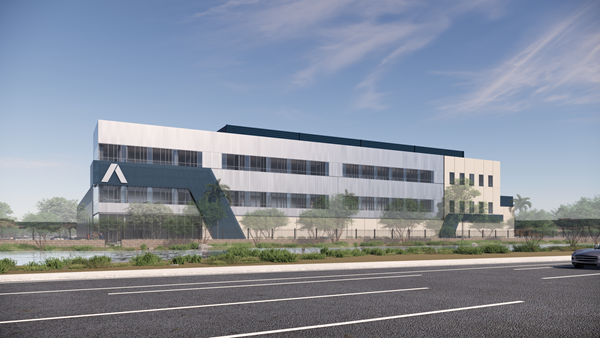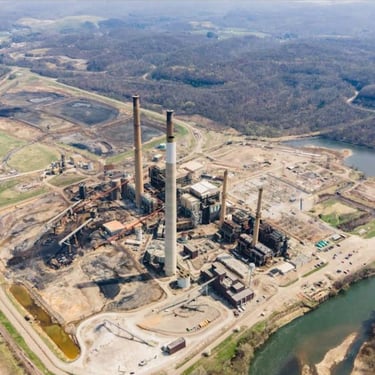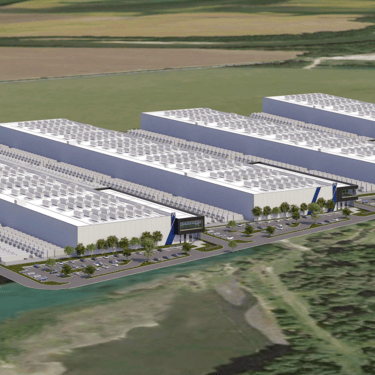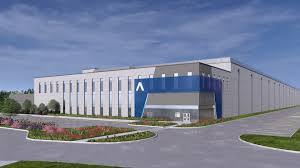Aligned Data Centers Expands in Ohio, Considering Nuclear Power for Resilience
Major Data Center Campus at Former Coal Plant Site needs 3.3GW of Electricity
NEWS
Miranda Morrow
7/27/202510 min temps de lecture


July 17, 2027 - COSHOCTON, OH - The new Coshocton AI campus is part of Aligned’s broader expansion in Ohio, marking its third data center campus in the state. Renderings suggest up to four large-scale data center buildings could be built on the site. The project is a multi-billion-dollar investment and has already secured a foundational customer for its first phase, with initial capacity expected by mid-2026. This timeline aligns with surging demand for computing power driven by cloud services and artificial intelligence. Aligned’s CEO, Andrew Schaap, stated that this expansion “reinforces [Aligned’s] commitment to providing future-ready digital infrastructure” and will help revitalize the legacy Conesville site, bringing new industries, high-quality jobs, and economic opportunities to Southeast Ohio. Local officials echo this optimism; Tiffany Swigert of the Coshocton Port Authority noted that “this development is further validation that Coshocton is poised to prosper in this new economy”, underscoring the transformation of a former coal energy hub into a digital infrastructure center.
Investment and Local Impact
Aligned’s Ohio expansion is part of a broader trend of data center growth in the Midwest. The company already broke ground on another Ohio campus in late 2024 on a 129-acre site near Sandusky (Erie County), which will host four buildings totaling 96 MW once fully built. Additionally, Aligned owns land in Pataskala (Licking County, east of Columbus) for future development. The Coshocton project, however, is unique due to its location on a former power plant brownfield site, leveraging existing grid infrastructure and land prepared for heavy industrial use. Such sites are highly attractive for data centers because they often come with robust transmission lines, substations, and water access already in place (critical for cooling and power supply).
The economic impact on the region is significant. Aligned projects that the Coshocton campus will create “thousands of construction jobs and hundreds of long-term operational roles,” greatly boosting the local economy. Data centers also contribute substantial tax revenue to local governments; in Ohio, data center developments can generate new tax streams that support public services and infrastructure. Aligned has expressed a commitment to community engagement, including partnerships for educational programs and environmental initiatives in Coshocton County. This is in line with the trend of tech infrastructure firms working closely with communities to ensure local benefits, such as workforce training and sustainability projects.
Exploring On-Site Nuclear Power for Resilience
While the new Coshocton campus will draw power from the regional electric grid, Aligned is reportedly interested in leveraging nuclear energy on-site and in the surrounding area to meet its massive power needs. The company’s vision includes potentially deploying small modular nuclear reactors (SMRs) or other advanced nuclear units at its data center locations. In particular, Aligned would like to see nuclear power generation capabilities established at the Coshocton campus itself, as well as in the nearby cities of Zanesville and Cambridge, Ohio (both within roughly 30–50 miles of Coshocton). Having dedicated nuclear power in these locations would give Aligned a direct source of carbon-free, always-on electricity for its data centers, rather than relying solely on the existing grid or distant power plants.
This strategic twist – integrating local nuclear power plants – is driven by goals of resiliency and redundancy in energy supply. By having on-site or close-proximity generation, Aligned could ensure that its critical facilities maintain power even if the wider grid faces outages or constraints. The former Conesville coal plant site is already a heavy industrial power location, which could be repurposed to host a modern nuclear micro-reactor, SMR, or LMR (Large Modular Reactor) in the future. In fact, across the United States there is growing interest in siting SMRs at retired coal plant sites due to their grid infrastructure and cooling water access. Ohio’s policymakers have also been warming to advanced nuclear technology as a source of clean, reliable energy. (Notably, Ohio enacted subsidies in 2019 to keep its existing nuclear plants viable, and nationally, half of the U.S. states have taken action in the last two years to promote nuclear power development.)
Large tech companies are already exploring nuclear options for data centers, lending credibility to Aligned’s nuclear ambitions. For example, Google has signed an agreement with Kairos Power to deploy multiple small reactors by 2035, and Meta (Facebook) announced similar plans to secure nuclear energy for its facilities. Microsoft went a step further by partnering in a deal to reopen the dormant Three Mile Island nuclear plant in Pennsylvania to power its AI data centers. Amazon Web Services is investing in SMR technology (through a stake in reactor developer X-energy) and is exploring projects to directly power its data centers with new nuclear plants. This industry trend underscores a key point: the power demands of hyperscale and AI-focused data centers are so enormous (often 100+ MW per campus) that operators are seeking dedicated, long-term energy solutions. Nuclear energy, with its 24/7 output and zero carbon emissions, is increasingly seen as an attractive complement to renewables for supporting data centers’ energy needs.
Benefits of Local Nuclear Generation
If Aligned succeeds in incorporating on-site or local nuclear power at Coshocton, Zanesville, or Cambridge, it would unlock several benefits both for the company and the surrounding communities:
Resilient Power Supply: On-site generation would insulate the data center campus from grid outages or transmission bottlenecks. Nuclear plants run at high reliability and could provide consistent baseload power, ensuring the data center (and critical customers) stay online 24/7 even during regional power disruptions. This kind of energy island approach greatly enhances uptime for mission-critical operations.
Reduced Transmission Losses: Locating generation near the load eliminates the need to send electricity over long distances. Transmission lines inherently lose some energy as heat (typically on the order of a few percent) due to resistance. By producing power on-site, line losses are minimized, improving overall efficiency. In general, a business located closer to power plants experiences lower line losses; distributed generation allows for on-site production and eliminates the need for long-distance power lines, which in turn can improve both efficiency and reliability of supply.
Cost Savings on Transmission & Distribution (T&D): Electricity drawn from the grid includes charges for transmission and distribution infrastructure. These T&D fees can be substantial, especially for energy-intensive users. By making behind-the-meter agreements or generating power on-site, Aligned could avoid many of those pass-through costs. For instance, a proposed data center project in Connecticut plans to purchase power directly from an adjacent nuclear plant (Dominion’s Millstone station) under a behind-the-meter setup, which would “significantly reduce energy costs for the data centers”. Similarly, local nuclear generation for Aligned could bypass expensive regional transmission tolls. (It’s worth noting that avoiding these fees is controversial – in one case, Amazon’s plan to directly power a data center from a Pennsylvania nuclear plant led to complaints that it would use the grid without paying the usual fees. Ultimately, AWS had to restructure that deal into a more traditional arrangement, illustrating the regulatory challenges around private bypass of grid costs.)
Selling Excess Capacity & Community Power: A group of small modular reactors (rumored to be Nuscale's voyager) deployed for Aligned’s campus would likely generate more power than the data center alone requires due to the consideration of redundancy and resiliency (especially during lower load periods). Think of it this way - run two 1GW reactors at half power so if one goes down for maintenance the other one can ramp up to full power to carry the load. Under this type of scenario - Aligned could sell excess electricity back to the grid or forge agreements with local utilities and municipalities to supply nearby residential and commercial customers. In effect, the data center’s power plant could also bolster the energy supply for Coshocton, Zanesville, and Cambridge, improving capacity for new industry in those areas. Such arrangements could be structured via direct power purchase agreements or microgrid-style partnerships with the communities. By providing carbon-free power to local grids or via behind-the-meter distribution to municipal utilities, Aligned’s generation assets would not only support its own facilities but also benefit the public. This concept would allow Aligned to act almost like a distributed energy partner to the region – akin to a private utility working alongside the traditional electric companies to support grid demand. The presence of a nearby generator could also improve local grid voltage stability and reliability, as less power has to be imported from far away.
Environmental and Economic Development Upside: Deploying advanced nuclear in lieu of drawing more power from fossil fuel plants helps meet sustainability goals (aligned with many tech companies’ commitments to carbon neutrality). It also creates high-tech energy jobs in the community. A nuclear-enabled data center campus could attract energy-intensive industrial partners (like manufacturers or research labs) to set up nearby, knowing there is abundant reliable power. This clustering effect can spur further economic growth in the Zanesville-Cambridge-Coshocton region. Additionally, nuclear reactors run without emitting air pollution or greenhouse gases during operation, supporting Ohio’s environmental targets while leveraging the state’s skilled workforce (many of whom have experience from the region’s legacy coal and manufacturing industries).
Challenges with Remote Power Dependency
Without local generation, Aligned’s Ohio campuses must source huge amounts of power from the broader electric grid, which in this area is part of the multi-state PJM Interconnection network. In practice, that means the new Coshocton data center might draw electricity from plants dozens or even hundreds of miles away. Currently, the closest large baseload generators of carbon-free power are the existing nuclear stations in Ohio and Pennsylvania, such as Davis–Besse, Perry, and Beaver Valley.
The Davis–Besse nuclear power station in northwest Ohio has one 894 MW reactor. Aligned's data center could be forced to rely on such distant plants via the grid. Davis–Besse, located near Oak Harbor in northwest Ohio, is an 894 MW pressurized-water reactor that began operation in 1978. Perry Nuclear Generating Station in Lake County (northeastern Ohio) is a larger single-unit boiling-water reactor (~1,258 MW) that came online in 1987. And just across the Ohio-Pennsylvania border lies Beaver Valley Power Station, a twin-reactor plant producing about 1,800 MW near Shippingport, PA. These facilities are key sources of carbon-free electricity in the region, and Aligned may effectively end up purchasing a portion of their output through utility contracts or power purchase agreements, delivered via high-voltage transmission lines.
Relying on distant power plants brings a few drawbacks. First, the electricity must travel over long transmission lines to reach Coshocton, incurring some energy loss and exposing the supply to grid congestion or outages. Typical transmission losses range from 2% to 5% (depending on distance, voltage, and line conditions). In other words, for every 100 MW sent, a few megawatts are lost as heat before reaching the destination. Those losses mean Aligned would need to buy extra capacity beyond its actual usage to account for the wastage. Additionally, if power is coming from hundreds of miles away, any grid disruption (storms, equipment failure, etc.) along the path could cut off the data center’s power unless it has sufficient on-site backup generation. This is a reliability concern – even if the remote nuclear plants are very reliable themselves, the transmission network adds an element of risk.
Another significant issue is cost. Utilities charge large customers not just for the energy (measured in MWh) but also for the infrastructure used to deliver that energy. These transmission and distribution charges can be steep for high-load facilities like data centers. Aligned would likely have to pay the local utility (or PJM grid operator) for network upgrades to handle its load, and it would incur demand-based T&D fees continuously. In Ohio, industrial power users sometimes face additional rider charges related to capacity and network maintenance. All of this could make the operating cost of power very high for Aligned if sourced purely through traditional means. The company would then pass some of these costs to its end customers (hyperscalers or enterprises leasing the data center space), potentially affecting competitiveness.
The contrast between this scenario and a local generation model is stark. In a local-generation scenario (like with on-site nuclear or a behind-the-meter supply), the data center might only use the grid as a backup or to export surplus, rather than for its primary supply. This reduces dependency on external utilities. For example, Amazon’s data center subsidiary initially pursued a fully behind-the-meter setup with a Pennsylvania nuclear plant to avoid certain grid fees, because under that arrangement, the data center wouldn’t be drawing through the regional transmission system. Regulators scrutinized that plan since it broke the usual mold and could let Amazon evade costs that other customers must pay. Ultimately, a compromise was reached with a front-of-meter PPA, but the appeal of behind-the-meter deals remains clear – significantly lower ongoing energy costs and improved self-sufficiency. Connecticut’s NE Edge project at Millstone is another case highlighting this dynamic: by tapping the nuclear station directly, the developers expect markedly lower energy prices for their 300 MW data center, a key factor in their business case.
Outlook: A Distributed Energy Partner Model
By incorporating nuclear energy into its campus plans, Aligned could position itself not just as a data center operator, but as an energy provider and partner in southeastern Ohio. The Coshocton data center campus has the potential to become a hub for both digital infrastructure and power generation innovation. If small nuclear reactors were built in Coshocton, Zanesville, or Cambridge in alignment with Aligned’s growth, the company would in effect operate a distributed power network alongside its data facilities. This would enhance the resilience of Aligned’s operations and could improve grid stability for nearby communities. Local businesses and residents would benefit from an additional reliable power source, and Aligned could earn revenue by selling any excess electricity or grid services (such as frequency regulation or emergency capacity) back into PJM.
Of course, realizing this vision requires navigating regulatory approvals, safety considerations, and significant capital investment in nuclear technology. The timeline for LMRs, SMRs, or micro-reactors coming online is likely several years out – Aligned’s immediate power will come from the existing grid mix (which in Ohio is still a combination of natural gas, coal, renewables, and nuclear) and will by the laws of supply and demand, raise energy costs dramatically. However, as data center energy consumption grows (U.S. data centers may account for ~8% of electricity usage by 2030, according to some estimates), the pressure to secure dedicated clean power sources increases as well. Aligned’s proactive interest in nuclear options indicates a forward-looking strategy to meet that challenge.
Aligned Data Centers’ expansion at the Conesville Industrial Park in Coshocton is not only a story of economic revitalization and digital infrastructure growth, but also a case study in the evolving intersection of data and energy. The company’s pursuit of on-site nuclear power in Coshocton, Zanesville, and Cambridge would provide unparalleled resiliency and cost stability for its operations. It would enable Aligned to supply power directly to its facilities and neighbors with minimal losses or middleman fees, essentially functioning as a distributed energy partner to the surrounding communities. While in the near term Aligned may have to rely on existing nuclear plants like Davis–Besse, Perry, and Beaver Valley (with all the incumbent transmission costs and complexities), the long-term plan of deploying new nuclear capacity on-site represents a bold bid for self-reliance and sustainability. If successful, it could set a template for future data center developments – where critical computing infrastructure is paired with dedicated clean power generation, securing the digital economy with the robust backbone of nuclear energy.
A rendering of Aligned's planned Coshocton data center campus in Ohio. Aligned Data Centers has announced a multi-building data center campus to be developed on a 197-acre parcel inside the Conesville Industrial Park in Coshocton County, Ohio. The site is adjacent to the former American Electric Power (AEP) Conesville coal power plant, a 2 GW facility that ceased operations in 2020 after over 60 years of service. The industrial park, created by the Frontier Group of Companies after acquiring the plant in 2020, offers heavy utility infrastructure and was “suitable for data center processing” according to the developer. Coshocton is located about 63 miles northeast of Columbus, making it part of a region that has recently attracted significant data center investment.







By Miranda Morrow - eGen Staff Reporter


